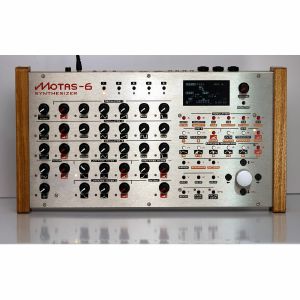Receive new release alerts for Motas Electronics
Filter
Equipment
Format
Featured
Price
Tags
Items 1 to 1 of 1 on page 1 of 1
Motas Electronics Motas-6 Paraphonic Vector-Morphing Synthesiser (stainless steel) (analogue desktop synthesiser)
Cat: 1061960 Rel: 02 Apr 25
Paraphonic vector-morphing synthesizer with fully analogue signal path, powerful digital control and a super-flexible independent modulation architecture.
Notes: A nice middle ground between old-school analogue and modern convenience here. The Motas-6 features a fully analogue six-voice paraphonic signal path, all controlled by digital elements for preset storage, modulation and sequencing.
Supplier's Notes:
Motas-6 is a very powerful and flexible analogue paraphonic synth with digital control. It has three voltage-controlled oscillators (VCOs) including hard-sync options, analogue phase-modulation and a sub-oscillator. Each VCO has several waveforms that can be freely mixed and modulated and each VCO can be assigned to track notes in various ways for paraphonic playing. The mixer takes the signals from the 3 oscillators, noise source and external input and outputs to the filters. The mixer output will distort (intentionally) with the highest input levels and there is a boost mode for even greater distortion. An analogue noise source with selectable white/pink response has its own control for input level into the mixer.
Motas-6 has a unique 'vector morphing' feature allowing you to morph between 4 patches of your choice in real-time using external MIDI controllers or CV inputs. There are 5 instant-access patches available at any time (in RAM memory). In vector morphing mode dual external controllers allow the active patch to morph in 2-dimensions between the first 4 presets. On exit from this mode the resulting patch settings are stored to the 5th preset automatically.
There are has masses of modulation options. Each and every rotary knob parameter has independent modulation settings from key, velocity, 4 modulation sources (from MIDI and CV/gate inputs) as well as from its own EG (Envelope Generator) and LFO (Low Frequency Oscillator) - a total of 33 independent EGs and LFOs! There are also 4 global EGs and 4 global LFOs with individual amount settings for each parameter.
Motas-6 has very powerful filtering capabilities. There is a 6-pole voltage-controlled low-pass filter (VCF) with adjustable resonance to self-oscillation (with selectable 1, 2, 3, 4, 5 and 6-pole outputs), a 2-pole high-pass voltage-controlled filter and a second 4-pole resonant low-pass VCF (similar in design to that of a certain silver box from the '80s). The inputs and outputs of the filters can be connected together in various ways to give a huge range of filtering possibilities.
It has a built-in pattern sequencer. 1-bar patterns of notes and parameter change data can be stored and chained to together into a 2 track sequence. In the sequence each pattern can be transposed, repeated and delayed. 15 patterns are active at any one time (56 patterns can be saved to non-volatile memory arranged in 7 banks of 8 patterns). 16 sequences can be saved (2 banks of 8 sequences). Not only does the saved sequence contain all 15 RAM patterns, also the 5 complete RAM patches are also saved ensuring that every detail of the sequence is captured. It also has a built-in arpeggiator that can be synced to internal or external clock (MIDI or CV/gate). Options including hold-modes, direction, note-range, swing, pattern, note-length and delay. The settings are stored with the patch.
The output voltage-controlled amplifier (VCA) stage has a choice of analogue clipping/distortion options: dry, soft clip, hard clip, soft clip + hard clip, dry + soft clip + hard clip. External audio can be routed into the mixer with its own level control. However, when nothing is plugged into the external audio input socket an audio feedback loop from after the final VCA is fed into the mixer instead. Audio monitoring options include real-time oscilloscope, spectrum analyser, volume level and MIDI input monitor displayed on the fast and bright OLED display.
… Read moreSupplier's Notes:
Motas-6 is a very powerful and flexible analogue paraphonic synth with digital control. It has three voltage-controlled oscillators (VCOs) including hard-sync options, analogue phase-modulation and a sub-oscillator. Each VCO has several waveforms that can be freely mixed and modulated and each VCO can be assigned to track notes in various ways for paraphonic playing. The mixer takes the signals from the 3 oscillators, noise source and external input and outputs to the filters. The mixer output will distort (intentionally) with the highest input levels and there is a boost mode for even greater distortion. An analogue noise source with selectable white/pink response has its own control for input level into the mixer.
Motas-6 has a unique 'vector morphing' feature allowing you to morph between 4 patches of your choice in real-time using external MIDI controllers or CV inputs. There are 5 instant-access patches available at any time (in RAM memory). In vector morphing mode dual external controllers allow the active patch to morph in 2-dimensions between the first 4 presets. On exit from this mode the resulting patch settings are stored to the 5th preset automatically.
There are has masses of modulation options. Each and every rotary knob parameter has independent modulation settings from key, velocity, 4 modulation sources (from MIDI and CV/gate inputs) as well as from its own EG (Envelope Generator) and LFO (Low Frequency Oscillator) - a total of 33 independent EGs and LFOs! There are also 4 global EGs and 4 global LFOs with individual amount settings for each parameter.
Motas-6 has very powerful filtering capabilities. There is a 6-pole voltage-controlled low-pass filter (VCF) with adjustable resonance to self-oscillation (with selectable 1, 2, 3, 4, 5 and 6-pole outputs), a 2-pole high-pass voltage-controlled filter and a second 4-pole resonant low-pass VCF (similar in design to that of a certain silver box from the '80s). The inputs and outputs of the filters can be connected together in various ways to give a huge range of filtering possibilities.
It has a built-in pattern sequencer. 1-bar patterns of notes and parameter change data can be stored and chained to together into a 2 track sequence. In the sequence each pattern can be transposed, repeated and delayed. 15 patterns are active at any one time (56 patterns can be saved to non-volatile memory arranged in 7 banks of 8 patterns). 16 sequences can be saved (2 banks of 8 sequences). Not only does the saved sequence contain all 15 RAM patterns, also the 5 complete RAM patches are also saved ensuring that every detail of the sequence is captured. It also has a built-in arpeggiator that can be synced to internal or external clock (MIDI or CV/gate). Options including hold-modes, direction, note-range, swing, pattern, note-length and delay. The settings are stored with the patch.
The output voltage-controlled amplifier (VCA) stage has a choice of analogue clipping/distortion options: dry, soft clip, hard clip, soft clip + hard clip, dry + soft clip + hard clip. External audio can be routed into the mixer with its own level control. However, when nothing is plugged into the external audio input socket an audio feedback loop from after the final VCA is fed into the mixer instead. Audio monitoring options include real-time oscilloscope, spectrum analyser, volume level and MIDI input monitor displayed on the fast and bright OLED display.
1 in stock $1,487.95
Click for better price!
or call +44 20 7424 1960
quote 1061960
quote 1061960
Items 1 to 1 of 1 on page 1 of 1

 USD
USD





